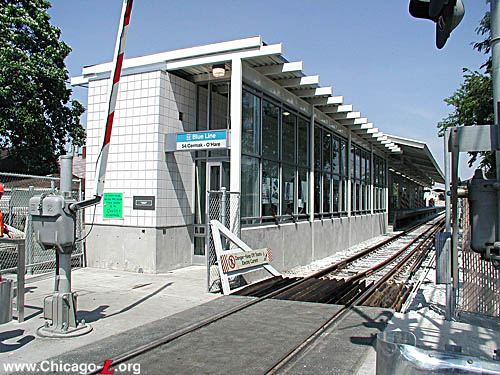
Kostner station, looking
east on June 24, 2003. Although at the time of this photo
it's actually still just under a month before the station
would open, the structure is substantially complete. The
CA's booth and fare controls, as well as some some auxiliary
rooms, are provided in the small, narrow station house
between the tracks. Accessibility is provided with an
ADA-compliant ramp. An auxiliary farecard-only entrance is
still provided at Kildare, the site of the original,
previous station's primary entrance. For a larger view,
click here.
(Photo by Graham
Garfield)
|
Kostner
(4400W/2100S)
Kostner Avenue and 21st
Street, North Lawndale
Service
Notes:

|
Pink Line:
Cermak (Douglas)
|

|
Accessible
Station
|
Quick Facts:
|
Address:
|
2019 S. Kostner
(Kostner
entrance)
|
|
2020 S. Kildare
(Kildare
entrance)
|
Established: May 22, 1907
Original Line: Metropolitan West Side Elevated, Douglas
Park branch
Previous Names: Kildare
|
Skip-Stop Type:
|

|
Station
|
Rebuilt: 2002-03
Status:
In Use
History:
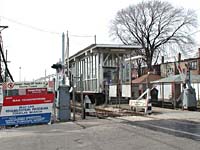
Kildare station, looking
west on March 11, 2002. The agent's booth and fare controls
on the platform were added in the 1970s when the station
house was demolished; the plexiglas enclosure was added
circa 2000. For a larger view, click here.
(Photo by Graham
Garfield)
|
The Douglas branch of the Metropolitan West Side Elevated Railroad
was originally planned to extend to 46th (Kenton) Avenue in its
original stretch. However, the branch was only open as far as
18th Street by April 28, 1896 (long after the
other Met branches were in service), Western
was activated August 7 and 40th
Avenue was finally reached in 1902. This station served as the
terminal for the Douglas Park branch until 1907 when the line was
finally extended to 46th Avenue at the city limits. The Kildare stop,
a station serving a primarily residential neighborhood of modest
density, was included in this last extension.
Kildare once resembled the Laramie
station, with a small wood frame clapboard peaked-roof station house
situated between the tracks facing the street with a back entrance
onto a short platform. In November 1973, an accident wrecked the
station house at Kildare and it was demolished. Only the original
platform and canopy remained, with an agent's booth added to the east
end of the platform. A long walkway replaced the building.
Kildare station, by 2002, had a twelve foot wide platform long
enough to hold an 8-car train, though the canopy was only one car
long.
As part of the CTA's Douglas
Rehabilitation Project, Kildare was replaced with a new station
house and a wider platform, with access provided by a ramp from the
street. At 0200 hours on Saturday, June 15, 2002, the stations at
Pulaski and Kildare closed for
demolition and replacement with new facilities. The weekend of June
22-23, 2002, Kildare station met its maker. On Saturday, the station
was quickly and completely demolished, including the platform,
lights, platform equipment, station enclosure, short canopy, sidewalk
leading to the station, and safety gate. By Sunday afternoon, June
23rd, nothing of the old station could be detected except for a very
short length of platform with one platform light wrapped around a
telephone pole a few hundred feet west of Kildare Avenue between the
tracks.
.
Douglas
Renovation Project
On August 5, 1998, the CTA Board approved a $2,131,551 contract to McDonough Associates, Inc.,
of Chicago to design improvements along the street level portion of
the Cermak (Douglas) route between Kildare and the terminal at
54/Cermak,
with funding for actual construction to be provided under the
Transportation Equity Act for the 21st Century, or TEA-21.
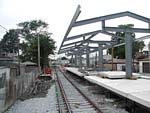
The wide, peaked canopy
begins to take shape at the west end of the Kostner station
platform, looking west on October 1, 2002. For a larger
view, click here.
(Photo by Graham
Garfield)
|
The new station fronts on Kostner (one block west of Kildare), with
an auxiliary fare card entrance on Kildare. As such, upon reopening
after reconstruction, the station's name changed from "Kildare" to
"Kostner".
The station house at Kostner, which has an all-glass elevation on
its south side for natural illumination, has white glazed tile
finishes on its non-windowed walls. The narrow building set between
the tracks houses the fare controls, AVMs, and customer assistant's
booth, as well as some auxiliary rooms, though much of those
equipment is actually housed in huts on the south side of the
right-of-way, just east of the station house. The Kostner entrance
has a ramp for ADA accessibility, while a reversible high-barrier
gate (HBG) allows customers with farecards to enter at Kildare, the
site of the station's original entrance in its previous
incarnation.
The new island platform is 16 feet wide with a 10-car canopy. The
canopies provide protection for waiting customers with windbreaks
with overhead heaters for cold-weather comfort. Audio/visual signs
and a public address system were also installed to provide travel
information for customers.
After Kildare station was closed on June 15, 2002, service was
shifted to a temporary station one block east. Kildare shared a
temporary station facility, centered over Karlov Street, with the
Pulaski station to the east. The
station was called the "Pulaski-Kildare" temporary station by
CTA and had two entrances: one
at Pulaski and one at Keeler, which was one block east of Kildare
Avenue and served as the entrance for those passengers who'd
previously used Kildare station. Station name signage calls the stop
"Pulaski", with the entrance serving Kildare acknowledged on a blue
tab. Kiewit/Delgado began construction of the temporary platforms at
Pulaski-Kildare
the weekend of May 4-5, 2002 and the temporary station entered
service on Monday, June 17th.
Some demolition work on Kildare station began immediately after it
closed on June 15th, primarily in the form of equipment removal for
the new, temporary facilities. During the weekend, after Kildare
station was closed and locked,
CTA forces removed the fare
controls and AVMs in that station and relocated them to the Keeler
entrance to the temporary Pulaski-Kildare
station.
The new Kostner station officially entered service at 0400 hours
on Thursday, July 17, 2003. Later that day, a press conference was
held, attended by Mayor Richard M. Daley,
CTA President Frank Kruesi,
and other officials to herald the opening of the new facility, which
was the first new station to come on-line as part of the
CTA's Douglas
Rehabilitation Project. At the same time that the new Kostner
station opened, the Keeler entrance to the temporary Pulaski-Kildare
station was converted to an emergency exit, effective as of the
closing of the line the night before. The east entrance of the
temporary station remained open for Pulaski
station customers until that station's rehabilitation was
complete.
The Kostner station also had new original artwork installed as
part of the Douglas branch renovation. Included through a unique
partnership between the Chicago Department of Cultural Affairs'
Public Art Program and the
CTA , the Public Art Program
administered the selection, design, creation and installation of
public art for the project. The Kostner station includes a digital
transfer on porcelain tile piece called "Birth of Heroes: A Mandala
for Harmony" on the streetside exterior wall by artist Ivan Watkins,
and jet-cut stainless steel fencing titled "Seeds of the Future are
Planted Today" by artist Beatrice Coron. The
CTA allocated $1 million for
the Cermak Branch Art Project and retains ownership rights to all of
the artwork created.
After conducting a West Side Corridor Study and holding public
meetings during 2004 and 2005, the
CTA began operation of a new
service over the Cermak
branch. Beginning Sunday, June 25, 2006, the new Pink
Line began providing the primary rail service to the branch.
Operating seven days a week during the same service hours as the
Blue Line had operated,
Pink Line trains operated
on the Cermak branch
from 54th/Cermak to Polk,
then terminated around the Loop
via the Paulina
Connector and Lake
branch of the Green
Line. Service levels increased with the introduction of the
Pink Line, with trains
running more frequently including a 7.5-minute interval during
weekday rush periods. To address community concerns, Blue
Line service to the O'Hare
branch from 54th/Cermak via the
Dearborn
Subway was maintained during morning and afternoon rush hours.
The Pink Line and revised
Blue Line services were
instituted as an 180-day experiment, extended for additional 180-day
experimental periods subsequently, while ridership and other effects
were studied. As the experimental period continued, the
CTA revised service on the
Cermak branch to
eliminate the rush period Blue
Line trains, leaving the Pink
Line to provide all service to 54th/Cermak.
Although ridership had risen overall since the introduction of the
Pink Line, Blue
Line trains had consistently low ridership on a
person-per-railcar-basis. The last day of Blue
Line Cermak
service was Friday, April 25, 2008.
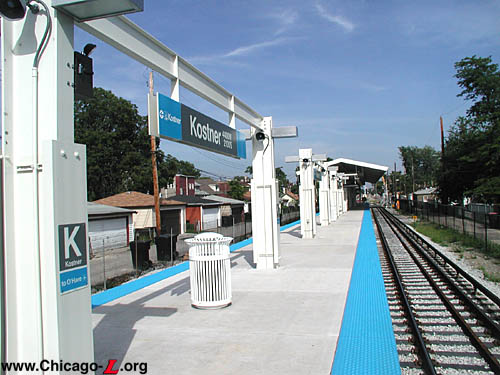
The center of the new island
platform at Kostner is uncovered, with peaked canopies at
the ends near the entrances. This August 2003 view looks
east toward the Kildare end, with the stocky, rectilinear
light poles forming a colonnade down the center of the
platform. For a larger view, click here.
(Photo by Graham
Garfield)
|
 Kildare
(1902-2002) |
Kostner
(2002-present)
Kildare
(1902-2002) |
Kostner
(2002-present)
For photos of the temporary Pulaski-Kildare
station, click here.
Kildare station
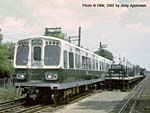
|
cta2147-48.jpg
(60k)
Pullman-Standard cars 2147-2148 are on westbound in
Douglas-Milwaukee "B" service as they leave Kildare station
in June, 1966. (Photo Jerry
Appleman)
|
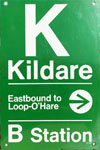 |
kildare-P-8_KDRsignEB.jpg (202k)
The design of this "KDR"-style
symbol sign from the inbound side of the platform at Kildare is typical of this type and vintage: large first letter of the station name with the full name under it; a "KDR arrow" pointing in the direction of travel with the direction and destination in the middle; and the skip-stop station type at the bottom. The color is also standard -- in the KDR signage system, a green background was used for 'B' station signs. (Sign courtesy of Bill Wulfert) |

|
kildare02.jpg
(120k)
The enclosed area on the east end of the platform was
added when the station house was removed. It now houses a
customer assistant's booth, a single farecard vending
machine (AVM), and two turnstiles. This view looks west on
March 11, 2002. (Photo by Graham
Garfield)
|

|
kildare03.jpg
(125k)
The Kildare platform has a small canopy -- barely one car
length -- that used to be attached to the rear of the wooden
station house (now removed). This short canopy, along with a
modern windbreak and overhead heaters, still provides some
protection from the weather in this view looking west on
March 11, 2002. (Photo by Graham
Garfield)
|
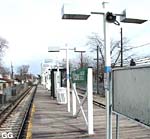
|
kildare04.jpg
(118k)
Looking east on the Kildare island platform on March 11,
2002. The station's accouterments are simple, belaying its
modest ridership and residential setting. (Photo by Graham Garfield)
|

|
kildare05.jpg
(143k)
Unlike many similar grade-level stations of modest
ridership on the system, Kildare still has most of its
signage, though it is somewhat spotty in places. It is
interesting to observe that most of the signs are on older
wooden frames and posts, some of which are leftover supports
from some long-removed structure. This view looks east on
March 11, 2002. (Photo by Graham
Garfield)
|
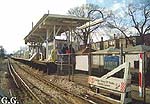
|
kildare06.jpg
(23k)
Kildare station, looking west in March 1998. Most likely,
there was a small station house a la Laramie
where the walkway is now. (Photo by Graham
Garfield)
|
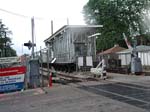
|
kildare07.jpg
(185k)
Kildare station on the last full day of service, June 14,
2002, looking northwest. (Photo by Graham
Garfield)
|
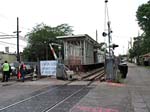
|
kildare08.jpg
(169k)
Kildare station on Monday, June 17, 2002, two days after
closure. The sign on the gate blocking the entrance directs
passengers to the Keeler entrance of the Pulaski-Kildare
temporary station. (Photo by Graham
Garfield)
|
Kostner
station

|
kostner01.jpg
(36k)
An artist's rendering of the new Kostner-Kildare station,
produced before construction began, shows a wider platform
and full-length canopy, the latter of which was not actually
executed (the finished station has a break in the canopy in
the middle of the station). (Drawing
provided courtesy of the Chicago Transit
Authority)
|
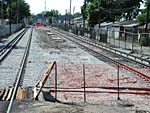
|
kildare09.jpg
(308k)
Looking west at the former location of Kildare station at
caissons for the supports for the future Kostner station on
August 2, 2002. (Photo by Graham
Garfield)
|
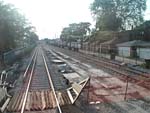
|
kildare10.jpg
(186k)
Caissons have been installed between Kildare and Kostner
for the new Kostner station, as seen in this view looking
west on August 31, 2002, allowing erection of the steel
structure to begin. (Photo by Graham
Garfield)
|
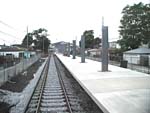
|
kostner03.jpg
(153k)
By October 1, 2002, the platform decking of the entire
Kostner station was in place, as well as most of the canopy
posts. (Photo by Graham Garfield)
|
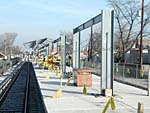
|
kostner04.jpg
(213k)
The new Kostner island platform is under construction,
looking east at the structural steel for the new canopy on
February 6, 2003. (Photo by Graham
Garfield)
|
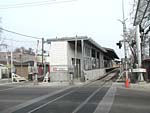
|
kostner05.jpg
(159k)
The primary entrance at Kostner to the new Kostner
station is nearing completion, looking east on March 18,
2003. The station house is narrow, with solid walls of white
tile on the front and north elevation and will have a clear
glass wall on the south elevation. (Photo by
Graham Garfield)
|
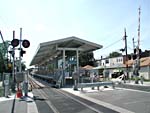
|
kostner08.jpg
(156k)
The Kostner station has an auxiliary, high-barrier gate
(HBG) farecard entrance at Kildare, on the same site as the
original station's entrance. This side has no station house
and is not ADA accessible. It was still a month away from
opening in this June 24, 2003 view looking west, but it was
already complete, including the installation of its
illuminated station entrance sign, except for the HBG
itself. (Photo by Graham
Garfield)
|
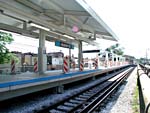
|
kostner09.jpg
(192k)
The Kostner platform is wider and longer than its
predecessor, with more canopy coverage and passenger
amenities. The station isn't open yet in this June 24, 2003
view and the striped, reflective barriers and rope strung
between them are in place to insure that the construction
personnel keep back from the platform edge, as trains still
operated through the station, albeit at reduced speeds. (Photo by Graham Garfield)
|
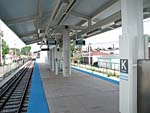
|
kostner11.jpg
(157k)
Upon reaching the platform from the main entrance,
passengers find themselves sheltered under one of the
station's two peaked canopies. This view looks east from the
off-peak boarding area at the Kostner end on August 19,
2003. (Photo by Graham Garfield)
|
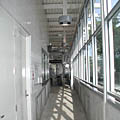
|
kostner12.jpg
(136k)
The main entrance to the station from Kostner is through
an enclosed station house. The front door leads to a narrow
passage, seen looking east on August 19, 2003, with
auxiliary rooms on the north and a glass curtain wall on the
south. Ahead are the fare controls. Note the windows on the
left toward the end of the hallway: this is the Customer
Assistant's booth, which is integrated into the interior
walls, unlike most stations where it's freestanding. (Photo by Graham Garfield)
|
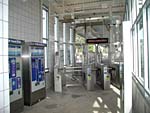
|
kostner13.jpg
(148k)
Once entering passengers pass through the entrance
hallway, they are deposited onto the small but
well-illuminated fare control area, seen looking east on
August 19, 2003. Extensive use of glass walls and windows
allow maximum natural light during daytime hours. The
turnstiles are angled both for efficient flow from the
entrance hall to the ramp to the platform, as well as to
allow more turnstiles to fit into a relatively small space. (Photo by Graham Garfield)
|
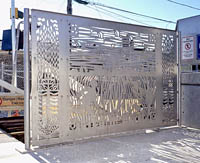
|
kostner-fence01.jpg
(533k)
Larger versions of Seeds of the Future..., artwork
that doubled as facing, are installed at the Kildare
auxiliary entrance and feature a center panel depicting
children watering plants in their neighborhood.
(Photo courtesy of CTA Arts in Transit
Program)
|
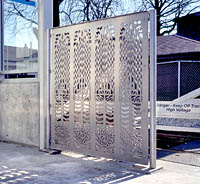
|
kostner-fence02.jpg
(137k)
The smaller Seeds of the Future... panels at the
Kostner entrance depict corn growing up from open books --
also use as side panels on the larger installation above --
symbolizing human growth.
(Photo courtesy of CTA Arts in
Transit Program)
|
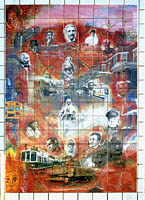
|
kostner_art01.jpg
(118k)
Birth of Heroes, mounted at the main entrance to
Kostner, has images of famous African-Americans, the
community, and the "L" screened onto its tiles. The artwork
is inspired by the Mandala, a precise yet universal symbol
of unity, harmony and the cyclical nature of
life.
(Photo courtesy of CTA Arts in
Transit Program)
|





























